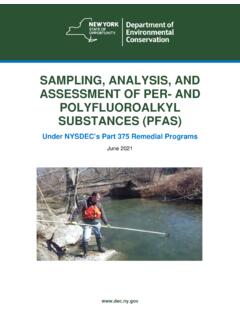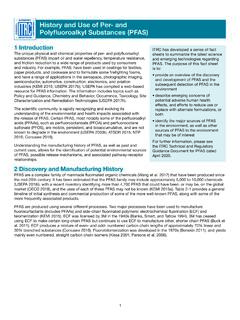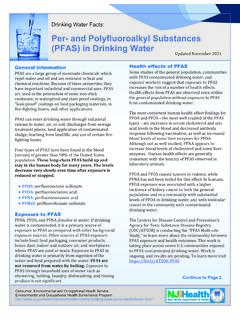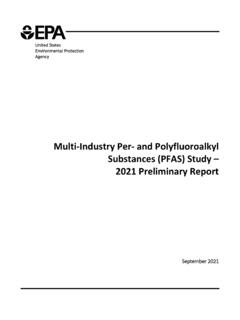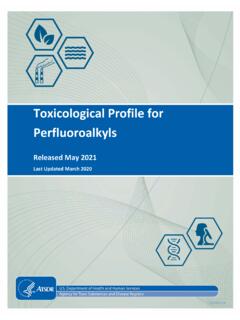Transcription of COMMITTEE AND THE COMMITTEE OF THE REGIONS …
1 EN EN EUROPEAN COMMISSION Brussels, SWD(2020) 249 final COMMISSION STAFF WORKING DOCUMENT Poly- and perfluoroalkyl substances (PFAS) Accompanying the document COMMUNICATION FROM THE COMMISSION TO THE EUROPEAN PARLIAMENT, THE COUNCIL, THE EUROPEAN ECONOMIC AND SOCIAL COMMITTEE AND THE COMMITTEE OF THE REGIONS Chemicals Strategy for Sustainability Towards a Toxic-Free Environment {COM(2020) 667 final} - {SWD(2020) 225 final} - {SWD(2020) 247 final} - {SWD(2020) 248 final} - {SWD(2020) 250 final} - {SWD(2020) 251 final} 1 COMMISSION STAFF WORKING DOCUMENT Poly- and perfluoroalkyl substances (PFAS) 1. What are PFAS: properties, uses, concerns and sources of emissions Poly- and perfluoroalkyl substances (PFAS) are a group of widely used man-made organic chemical substances.
2 They contain alkyl groups1 on which all or many of the hydrogen atoms have been replaced with fluorine2. Well known PFAS contain fully fluorinated carbon chains3 of various chain lengths attached to a functional group, like carboxylic or sulfonic acids. Such groups are called perfluorinated acids and include PFOA4 and PFOS5. Shorter chain PFAS have been developed more recently to substitute the longer chain ones. In this context, an important distinction is the one between long chain and short chain PFAS6. The PFAS group includes also polymers: fluoropolymers7, perfluoropolyethers8 and side-chain fluorinated polymers9. The OECD has published a clear explanation of the different groups of PFAS10.
3 Examples of typical PFAS structures are shown in Figure 1. 1 An alkyl is a functional group that contains only carbon and hydrogen atoms. 2 In Buck et al. (2011) the definition of per- and polyfuoroalkyl substances (PFAS) was the highly fluorinated aliphatic substances that contain 1 or more C atoms on which all the H substituents have been replaced by F atoms, in such a manner that they contain the perfluoroalkyl moiety CnF2n+1 (where n is equal to or greater than 1, the structure must contain at least one CF3 group). In 2018, OECD Global PFC Group defined PFAS as chemicals with at least one perfluorocarbon moiety ( CnF2n ). 3 In a fully fluorinated carbon chain, all hydrogen atoms have been replaced by fluorine.
4 4 PFOA is the abbreviation for Perfluorooctanoic acid 5 PFOS is the abbreviation for Perfluoroctane sulfonic acid 6 Long-chain PFAS include perfluoroalkyl carboxylic acids (PFCA) with 7 or more perfluorinated carbons, perfluoroalkane sulfonic acids (PFSA) with 6 or more perfluorinated carbons, and their precursors. This distinction applies only to PFCAs, PFSAs and their precursors. 7 Fluoropolymers have a carbon-only backbone with fluorine atoms directly attached to it. 8 Perfluoropolyethers have a carbon and oxygen backbone with fluorine atoms directly attached to the carbon atoms. 9 Side-chain fluorinated polymers have a non-fluorinated backbone with fluorinated side chains. 10 2 Figure 1: Examples of PFAS chemistries.
5 From Kwiatkowski et al. (2020), Environ. Sci. Technol. Lett. 2020, 7, 8, 532-543 Functional groups in PFAS substances can be variable11, and this variability explains both the large number of PFAS and their different applications. A 2015 study reported that more than 3,000 PFAS were on the global market for commercial use12. In 2018, the OECD found over 4,700 different CAS numbers for PFAS13. The number of PFAS commercially produced and used could be even higher, as in some cases their identities are considered confidential business information and impurities and by-products are not declared. The carbon-fluorine bond is extremely strong and stable14. When the non-polar fluorocarbon chain is linked to a polar structure, the PFAS become surfactants.
6 These characteristics give PFAS very useful properties, such as oil and water repellence, high chemical, physical and temperature resistance and ability to act as surfactants. Because of such properties and of the structural variability due to the functional groups, PFAS have been used in a wide variety of products and industrial applications. Their uses include polymerisation aids in fluoropolymers production, surfactants in fire-fighting foams, anti-mist agents in chromium plating, water - 11 Examples of functional groups include alcohols (-OH), amines (-NH2), halogens (-F, -Cl, -Br, -I), esters (-CO2R), ethers (-O-), thiols (-SH), carboxylic acids (-CO2H), sulfonic acids (-SO3H), sulfinic acids (-SO2H), sulfones (-SO2R), phosphate acids (-PO(OH)2), phosphinic acids (-PO(OH)), as well as their derivatives, including salt forms and polymers (OECD 2018, Gl ge et al.)
7 2020). 12 Swedish Chemicals Agency (2015), Occurrence and use of highly fluorinated substances and alternatives: Report from a government assignment. 13 For a list of 4,730 PFAS-related CAS numbers compiled from publicly accessible sources of information, see OECD (2018), Toward a new comprehensive global database of per and polyfluoroalkyl substances (PFASs): summary report on updating the OECD 2007 list of per and polyfluoroalkyl substances (PFASs). 14 3 and oil repellence in textiles, leather, food contact materials and cosmetics. They are also used in the production of components of semiconductors and medical devices, as co-formulant in plant protection products, biocides, feed additives, pharmaceuticals and paints.
8 A recent study identified more than 200 use categories and subcategories for more than 1400 individual PFAS15. The very strong bond between carbon and fluorine, that gives PFAS their properties, is also responsible for their main concern: they are persistent. While some of the more complex molecules can partially degrade, they will ultimately form a PFAS that is persistent in the environment (such as PFOA or PFOS and smaller perfluorinated substances). Substances with a non-fluorinated (hydrocarbon) part in addition to their PFAS-elements often degrade until they reach persistent PFAS degradation products16. Another characteristic shared by some of the short-chain and generally small PFAS is their mobility in the environment17.
9 This property, combined with persistency, causes PFAS accumulation in water bodies, drinking water , plants and air. A large number of PFAS contamination cases of water (including drinking water18) and soil have been detected in the EU and globally19. Some PFAS can be highly mobile in air, leading to their accumulation and transport over long distances20. Several PFAS can also bioaccumulate21 in humans, animals and plants and, among the few that are well studied, most are considered to be toxic. Some PFAS are classified as Persistent, Bioaccumulative and Toxic (PBT) and very Persistent and very Bioaccumulative (vPvB) under REACH22. The European Environment Agency23 lists the main effects of PFAS on human health, which include thyroid disease, increased cholesterol levels, effects on reproduction and fertility, immunotoxicity, liver damage, kidney and testicular cancer.
10 Immunotoxicity and endocrine effects have been reported for some PFAS. A recent opinion from the European Food Safety Agency (EFSA) concluded that both PFOS and PFOA are associated with reduced antibody response to vaccination. PFOS also causes a reduced resistance to infection. EFSA concluded that parts of the European population exceeds the tolerable weekly intake from food of four PFAS24. Reported effects of PFAS on aquatic and terrestrial animals include survival, growth, development and reproduction25. A main source of PFAS to humans and the environment is their production and use in industrial and professional installations, as production of fluoropolymers, use of fire- 15 Gluge et al (2020), An overview of the uses of per- and polyfluoroalkyl substances (PFAS).












